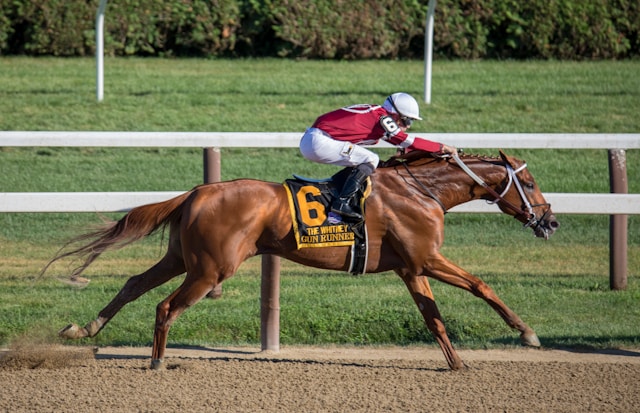- Change theme
From Stable to Starting Gate: A Day in the Life of a Racehorse

Behind every racehorse thundering down the track is a world of meticulous care, dedication, and routine.
04:29 09 May 2025
Behind every racehorse thundering down the track is a world of meticulous care, dedication, and routine. The glamorous moments we see—the powerful strides, the thrilling finishes—are the product of hours of preparation that begin long before the starting gate opens. A day in the life of a racehorse is carefully choreographed to balance training, nutrition, rest, and human connection. It’s a delicate routine designed to nurture peak performance while safeguarding the horse’s well-being.
Let’s step into the world of these remarkable athletes and explore what a typical day looks like, from the quiet hours in the stable to the adrenaline rush of race time.
Dawn at the Stables
The day starts early—well before sunrise. As the first light appears, the stable comes alive with activity. Grooms arrive to feed the horses their morning ration of hay and specially formulated grain, tailored to each horse’s dietary needs. Nutrition plays a vital role in a racehorse’s health and stamina, and every calorie is measured for optimal energy.
Once fed, the horses are walked to loosen their muscles and aid digestion. These early walks aren’t just about exercise; they’re a way for handlers to observe each horse’s demeanor and physical condition. A slight limp or reluctance to walk might signal a brewing issue that needs veterinary attention.
Trainers begin planning the morning workouts, considering factors like upcoming races, fitness levels, and track conditions. According to one popular horse racing resource, this morning routine is where much of a horse’s competitive potential is honed. The partnership between trainer, jockey, and horse starts here, built on communication, observation, and trust.
Morning Workouts: Training with Purpose
After the warm-up walk, it’s time for the main event: the workout. Racehorses typically train on a designated track, either galloping alone or in company with other horses. Each session is tailored to the horse’s current fitness level and goals—some days might focus on building stamina with longer gallops, while others emphasize speed with shorter, faster breezes.
Jockeys or exercise riders guide the horses through these workouts, providing valuable feedback to trainers about how the horse feels under saddle. A well-timed breeze can simulate race-day conditions, helping the horse develop confidence and sharpness.
Cooling down after a workout is critical. Horses are walked again, then bathed and cooled with water to prevent overheating. Their legs may be wrapped in cold therapy or poulticed to reduce inflammation and support recovery. Every detail of the post-workout care is aimed at preserving soundness and preventing injury.
Midday Rest and Relaxation
By late morning, the horses are back in their stalls, munching on hay or resting quietly. A racehorse’s midday hours are largely devoted to relaxation. Rest is as important as training, allowing the body to repair and the mind to reset.
During this time, veterinarians may visit to perform routine health checks or address any concerns raised by the morning’s observations. Farriers also play a key role, ensuring each horse’s hooves are properly trimmed and shod to support movement and minimize stress on joints.
Massage therapists, chiropractors, and other specialists may visit as part of the horse’s care team. The goal is holistic support, addressing both physical and mental well-being to keep the horse comfortable and race-ready.
Afternoon Walks and Enrichment
In the afternoon, many racehorses enjoy another hand-walk or light turnout in a small paddock, depending on the stable’s routine and the horse’s temperament. Time outside the stall helps maintain circulation, prevents stiffness, and provides mental stimulation.
Some horses are naturally high-strung, so trainers and grooms incorporate enrichment activities to keep them engaged without overstimulating. A calm mind is essential for a racehorse; anxiety or excess nervous energy can impact performance at the starting gate.
Throughout the day, barn staff meticulously clean the stalls, refresh water buckets, and ensure bedding is dry and comfortable. Cleanliness isn’t just for appearances—it’s vital for preventing respiratory issues and infections.
Preparing for Race Day
If the horse is scheduled to race, the daily routine includes additional steps. Grooming becomes even more meticulous, with coats brushed to a gleaming shine. Tack is checked and prepared, racing silks are readied, and transport plans are confirmed.
On race day, horses are loaded into trailers and transported to the racetrack, where they settle into assigned stalls. Handlers monitor hydration, feeding, and stress levels during the transition. The pre-race hours are a balance of quiet preparation and nervous anticipation.
Before heading to the paddock, horses are walked, saddled, and checked by officials. Jockeys meet with trainers to discuss strategy, then mount up and head to the parade ring. Fans watch eagerly as the horses file toward the track, muscles rippling, ears pricked forward, eyes bright with readiness.
The Starting Gate: A Culmination of Care
As the horses enter the starting gate, the culmination of countless small moments unfolds. Every early morning feed, every meticulously planned workout, every walk and brushstroke has led to this point. It’s not just the horse’s talent on display—it’s the dedication of an entire team.
When the gates fly open and the horses surge forward, it’s a celebration of athleticism, preparation, and heart. Win or lose, the journey from stable to starting gate is a testament to the care, commitment, and respect that define the world of horse racing.
For fans, bettors, and professionals alike, understanding the depth of a racehorse’s daily routine deepens appreciation for the sport. Behind every thunderous finish is a quiet morning, a thoughtful plan, and a powerful partnership between humans and horses.
